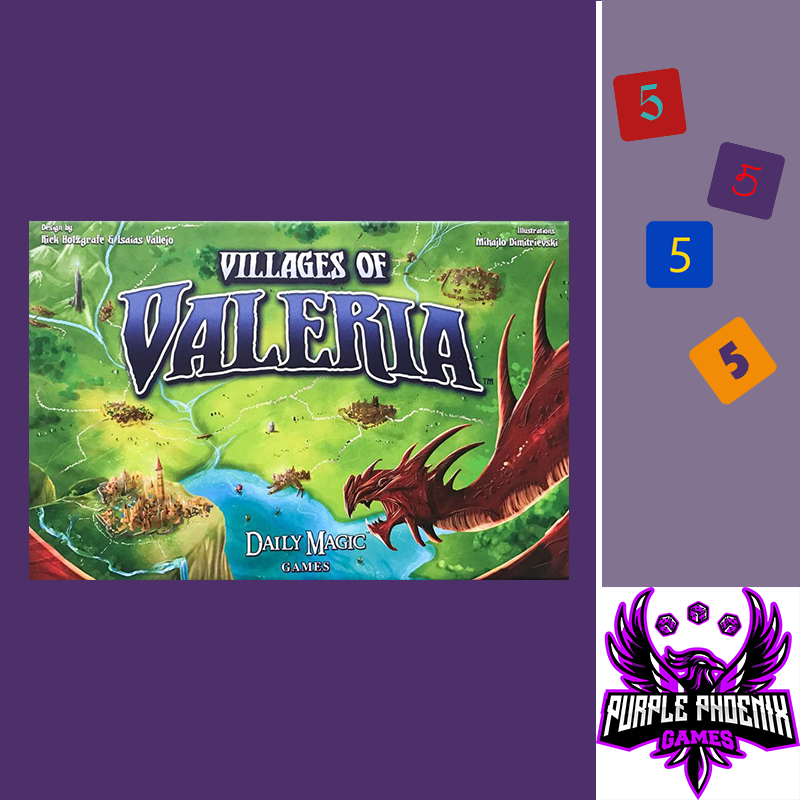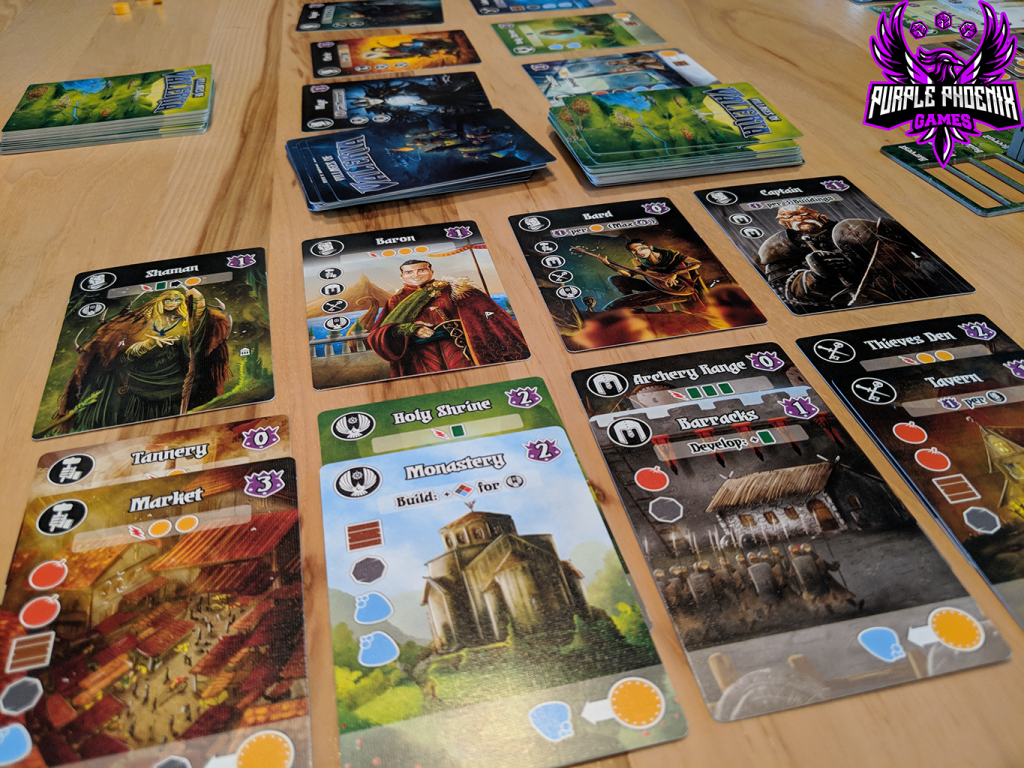
Oh, Valeria. How I do love thee! I have reviewed Valeria: Card Kingdoms (VCK) in the past and if you read that review you learned that it is my favorite game of all time (as of the date of this composition). I actually Kickstarted Villages of Valeria (VoV) before even playing VCK so this game was my introduction into the Valeriaverse. I feel obligated to publicly thank VoV for bringing me into one of my favorite gaming universes. But, how good IS this one?
| Villages of Valeria (2017) | Daily Magic Games |
| 1-5 Players | 30-60 minutes |
| Ages 14+ | BGG Weight – 2.30 / 5 |
In VoV you are a Duke/Duchess being charged by the King to found a new Capital City to replace the previous one that has been ravaged by the wars played out in VCK. The King has assigned you a castle to use as your HQ and expects the most enterprising Duke/Duchess to win the day by building the most flourishing village. Will you be able to create the resources necessary to build the most attractive buildings that adventurers will want to frequent? Or will you spend your time taxing your constituents to death?
DISCLAIMER: This review focuses on vanilla Villages of Valeria. We have all the released expansions and may do a review of them in the future. If we do, we will edit this review or link to the new review here. -T
VoV uses a handful of really great game mechanics that will be familiar to some gamers, but not intimidating enough to scare off new gamers, that really work well together to create an excellent gaming experience. I will address most of them here, but please do not use this review as a replacement for the rulebook, as I will not be addressing every single rule.
VoV is played over several rounds where every player will be taking a turn as the active player until someone has built the requisite number of buildings prescribed in the rulebook to trigger the end of the game. Each player starts with a castle card that provides a wild resource of your choice when you need to pay resources to build buildings on future turns. You are also given gold and a starting hand of cards in accordance with setup rules. Setup the decks of cards and create the offer rows for each and you are ready to play!
When you are the active player you will take an action from a list of five available actions: Harvest, Develop, Build, Recruit, and Tax. If you choose to Harvest on your turn you will draw three cards from either the face-up green building cards on the offer or blindly from the deck of green building cards. To Develop you will play a building card from your hand to the back of your castle, tucked underneath and upside down, to be used as the resources printed at the bottom of the card (wood, magic, stone, food). These resources are now available to be used for the build action (think of the brown and gray cards in 7 Wonders, if you’re familiar). When you take the Build action, you will be playing a building card from your hand to be built in the tableau in front of you. Since number of buildings is the end game trigger condition, you will be trying to build buildings as much as possible. All building cards have a cost printed on the left side of the card, and those costs will need to be paid for by using the gold you possess. You can use one gold on your own castle card as it provides a wild resource to you, and you can use one gold per card you have Developed previously for their resource benefit. You may even spend your gold to use an opponent’s resources (not their castle! – also akin to 7 Wonders neighbor resource purchasing). The catch here is that you lose that gold piece to your opponent, but they will not be able to use that resource until the beginning of their turn as active player. Most buildings will have benefits printed on them that either take effect immediately or when triggered by another action. When you Recruit an Adventurer, you are using your village’s buildings to attract them to your cause. Each Adventurer’s cost to recruit is printed on the side of the card, and these costs are paid by having the matching symbols on building cards in your village. Once recruited, these Adventurers can also enact conditional abilities similar to building cards, but usually will be advantages to final VP scores. By taking the Tax action you will take one gold from the bank and draw a building card from the offer or the deck.
Now this all seems pretty easy and I have only really mentioned one form of tension by blocking opponents’ use of their own resources if you spend a gold to use it on your turn. Since you reclaim all gold on your castle and resource cards in your village at the beginning of your turn this should cause no problems, right? Well, VoV also uses the follow mechanic that has been employed by other games previously. When you are the active player you choose which action you want to take on your turn, complete that action, and then the same action is offered to your opponents for them to take at a disadvantage. Example: I choose Tax as my action, so I take my gold and my card and my turn is over. Then, going around the table, each player can decide to follow my action but are only able to take a building card as a follow action. No gold. Each action has a Lead and Follow benefit, so you are always paying attention during the game, even on others’ turns because you might still benefit from the chosen actions.
Play continues like this with active player Lead actions and possible others’ Follow actions until someone triggers the end game condition. Then everyone completes the turn and VPs from all cards in your tableau are added (including gold pieces you collected). Most VPs wins the game of Villages of Valeria!
Components. Okay, I have to admit that I have the Kickstarter Deluxe version of this game so I am only speaking from experience with that version. The cards are of really good quality. The gold tokens and active player castle token are great, but the action tracker we found a bit cumbersome to use so we just, like, didn’t. The building tracker and castleeples are great as well. The art is by The Mico, and I just love his art style, so that’s a big positive for me. Overall, the components are really really nice.
So why do I love this game? Well, it’s really a mashup of mechanics that work well for me. I love the Lead/Follow mechanic. I love 7 Wonders, so borrowing some of those mechanics and nuances is a great fit for me. I absolutely LOVE The Mico’s artwork on every Valeria game. No two games of VoV will be alike because the amount of cards that come inside the box (and growing with every expansion) gives such a diverse gaming experience that I love playing. If you like any of the Valeria games and you have yet to try Villages of Valeria you MUST find a copy. You will be drawn in by the familiar feel of Valeria and mechanics from classic games that will surely delight. We at Purple Phoenix Games give this gem a bustling 20 / 24. Long live Valeria!

